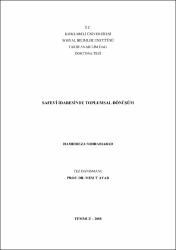Safevî İdaresinde Toplumsal Dönüşüm

View/
Access
info:eu-repo/semantics/openAccesshttp://creativecommons.org/licenses/by-nc-nd/3.0/us/Date
2018-08-08Metadata
Show full item recordCitation
Sohrabıabad, H. (2018). Safevî İdaresinde Toplumsal Dönüşüm. Doktora Tezi. Kırklareli Üniversitesi Sosyal Bilimler Enstitüsü, Kırklareli.Abstract
On altıncı yüzyılın başlarından on sekizinci yüzyılın ortalarına kadar tarih sahnesinde kalan Safevî Devleti, Balkanlar’dan Orta Asya’ya, Kafkaslardan Hürmüz Boğazı’na kadar çok geniş bir coğrafyada bugün de etkileri devam eden değerli bir tarihsel figürdür. Bu nedenle İran, Türkiye, Avrupa, Japonya ve Amerika’da Safevîler üzerine dikkat çekici bir akademik ilgiden söz edilebilir. Çünkü tarih sahnesinde dinî bir tarikatın çekirdeğini oluşturduğu bu denli güçlü bir siyasi yapı sıkça karşılaşılabilecek bir olgu olmadığı gibi görmezden gelinebilecek bir durum da değildir. Gerçeği söylemek gerekirse Safevî araştırmalarının asıl zorluğu da sözü edilen mistik ve cezbedici çekirdek ile bunun tarihsel yansımalarından kaynaklanmaktadır. Tarihî Azerbaycan ve günümüz İran’ında geçerli olan Safevîlerle halef selef ilişkisi, Türkiye için Osmanlı mirasından ve mezhepsel yapıdan kaynaklanan kadim ötekilik durumu ve son olarak Müslüman olmayan ülkelerde -özellikle Batı’da- İslâm’ın heterodoks yüzünün siyasi temsilcisi olması vasfı, Safevî çalışmalarını çok katmanlı ve ideolojik önyargılara açık bir zemine kaydırabilmektedir. Bu nedenle Safevîlerle ilgili çalışmalar, ya kronolojik bir siyasi tarih düzleminde ya da söz konusu ideolojik bakışların yönlendirmesinde belirli bir güzergâha mahkûm gibidir. Çalışmamızda bizden öncekileri tekrar etmemek adına Safevî tarihinin kronolojik boyutu ana hatlarıyla sınırlı tutulmuştur. Araştırmanın merkezine Safevî Devleti’nin, Karakoyunlular ve Akkoyunlular gibi kendilerinden önceki Türk devletleriyle etkileşimleri, idari yapılanma, ordu yapısı, etnik, kültürel ve ekonomik yapılar açısından sebep sonuç ilişkisi gözetilerek v yerleştirilmiştir. Böylelikle Safevîlerin varoluş süreci bir devamlılık iddiasına oturtulmuştur. Böylece Karakoyunlular ve Akkoyunluların askerî, idarî, etnik ve ekonomik özelliklerinin Safevîler’deki yansımaları somut verilere dayandırılmıştır. Bahsedilen iki Türkmen devleti ile Safevîler arasındaki temel farklılık olan Safevî Tarikatı’nın devlet içindeki konumu -devletleşme öncesi ve sonrasıyla birlikte- tarihsel gelişimi içinde ele alınmıştır. Safevî Devleti tarihi, Şah İsmail’den Tahmasb’ın birinci dönemine kadar I. Dönem olarak adlandırılmış ve bu adlandırmanın idari, etnik ve dinî sebepleri ortaya konmuştur. Erdebil Tekkesi etrafında örgütlenen Kızılbaş Türkmenler tarafından kurulan devletin Tahmasb’la başlayan değişimi açıklanmış, bu değişimin hem devlete hem de inanç sitemine nüfuz ediş süreci izah edilmiştir. Bu süreç, yalnızca bölgedeki demografik yapının değil; Hazar’ın Batısından Anadolu içlerine, Kafkasların eteklerinden Arap Yarımadası kapılarına kadar bölgenin inanç haritasının da değişimine etki etmiştir. Bu gerçeklik sözü edilen bölgenin siyasi, etnik ve inanç tarihinin aydınlatılması adına hayatidir. Safevîler hakkındaki bu çalışma, başta İran olmak üzere Osmanlı ve Cumhuriyet’in, başta Türkmenler olmak üzere ilgili tüm etnik yapıların, en çok da Kızılbaşlık ve Şia’nın daha iyi anlaşılmasına hizmet edecektir. Remained on the stage of history from the early of 14th century to the middle of 18th century, Safavid Empire is a valuable historical figure of which effects are also continuing today on a too wide geography from the Balkans to Middle Asia, the Caucasus to the Strait of Hormuz. For this reason, a remarkable academic interest in the Safavids can be mentioned in Iran, Turkey, Europe, Japan and USA. Because, on the stage of history, such a strong political structure of which core is constituted by a religious sect is neither a fact that would be able to be encountered frequently, nor a situation that would be able to be neglected. To be truthful, the real difficulty of Safavian studies is due to the said mystic and charming core and the historical reflections of this. Successor-predecessor relationship with the Safavids, which is current in the historical Azerbaijan and today’s Iran; state of the old otherness arising from Ottoman heritage and denominational (sect) structure, for Turkey; and finally, feature of its being political representative of heterodox face of Islam in the non-muslim countries ? particularly in the West; can slide Safavian studies to a platform that is vulnerable to multi-layer and ideological prejudices. Therefore, studies on the Safavids are like the doomed to a certain course either on a chronological plane of political history or in directing the said ideological points of view. In our study, we confined chronological dimension of Safavid Empire to broad strokes in order not to repeat those before us. We put interactions of Safavid Empire with Turkish states such as the Qara-Qoyunlus and Aq-Qoyunlus who came before the Safavids, into the center of the study, by paying regard to the cause and effect relationship in terms of administrative structuring, army structure, and ethnical, cultural and economical structures. vii Thus, we placed existence process of the Safavids into a claim of continuity. So, reflections of military, administrative, ethnical and economical features of the Qara-Qoyunlus and Aq-Qoyunlus on the Safavids were based on tangible data. We addressed position, within the the state, of Safavid Sect which is essential difference between the said two Turkmen states and the Safavids ? together with before and after state formation ? within its historical development. We named the history of the Safavid Empire as ‘First Period’ from Shah Ismail I to the first period of Shah Tahmasb I and put forward administrative, ethnical and religious reasons of this naming. We explained the change which began with Shah Tahmasb I in the state that was founded by the Qizilbash Turkmen who were organized around Ardabil Lodge, and we showed forth penetration process of this change into both the state and belief system. This process had an effect on the change not only in demographic structure in the region, but also in belief map of the region, from Western Part of Khazar into the inlands of Anatolia, mountain foots of the Caucasus to the gates of Arabian Peninsula. This reality is vital to enlighten political, ethnical and belief-related history of the above-mentioned region. This study which is about the Safavid Empire, will help to understand better the Ottoman and the Republic of Turkey, in particular to Iran, the relevant all ethnical structures, including the Turkmen, and Qizilbashness and the Shi’a none more so than.
Collections
- Tez Koleksiyonu [311]
The following license files are associated with this item:



















